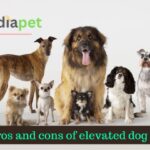The ACD (Australian Cattle Dog) is highly intelligent and easily trainable. As a working dog, they require both mental and physical stimulation to stay happy. They are obedient and can follow commands well, but they also use their intelligence to problem-solve and achieve goals. Once trained, they make excellent companions and are extremely loyal.
However, ACDs have a tendency to nip at small children, so early and gentle socialization is crucial to address this behavior. They thrive when given a job to do, so engaging them in activities like flyball or agility is essential to prevent boredom. Without sufficient mental and physical stimulation, they may become destructive.
ACDs can get along well with older children and other pets if introduced early on, but they may be initially cautious around strangers. They are protective of their family and home, making them good watch dogs. Due to their high energy levels, they make excellent running or jogging partners and require a significant amount of daily exercise.
They don’t like being left alone for long periods and are best suited to someone with an active lifestyle and outdoor job where they can be involved. ACDs enjoy companionship and will reward their owners with loyalty and devotion. It’s important to note that they need ongoing training to keep their minds occupied. Providing them with various forms of mental stimulation, such as teaching new tricks, is highly beneficial as they enjoy learning.
While ACDs can be stubborn, they genuinely want to please their owners. They often develop a strong bond with one particular family member whom they see as their pack leader.
In terms of grooming, ACDs shed moderately and require daily brushing to prevent excessive hair in the home. They can be prone to health issues like Canine Hip Dysplasia, and deafness or eye problems are relatively common in the breed.
Brown Cattle Dog In the early 1800s, large portions of Australia opened up for cattle grazing, requiring a herding dog capable of covering long distances. Around 1840, a man named Hall crossbred Blue Merle Highland Collies with domesticated Dingoes, giving rise to the first Australian Cattle Dog, known as Hall’s Heelers. These dogs demonstrated exceptional ability in navigating extensive and rugged terrain. They used their mouths to guide wild cattle and nipped at them to direct their movement. Further crossbreeding with Bull Terriers, Dalmatians, and Black and Tan Kelpies resulted in the development of the Australian Heeler, which was later renamed the Australian Cattle Dog around 1897.
Australian Cattle Dogs have intelligent, resilient, and independent temperaments. They were bred to work tirelessly in hot environments, displaying remarkable stamina. To keep them content, they require ample exercise and mental stimulation. While they may tend to be aloof with other dogs, early socialization is crucial to promote positive interactions.
These dogs thoroughly enjoy playtime and can be compatible with children, although they have a tendency to nip at family members’ heels as an instinct to herd. It is vital to firmly discourage this nipping behavior.
Health issues that can be associated with Australian Cattle Dogs include canine hip dysplasia (CHD), and progressive retinal atrophy (PRA) which leads to blindness due to retinal degeneration, deafness, and elbow dysplasia.
5 Cattle Dog Breeds Border Collie Border Collies are renowned as highly skilled herding dogs, capable of training both humans and other animals. They are not only considered one of the most intelligent dog breeds but also one of the fastest, reaching speeds of up to 30 mph. While they are affectionate towards their family, they are not suited to a sedentary lifestyle as mere porch dogs. Responsible dog owners understand that these Scottish-Welsh marvels require rigorous daily exercise and engaging activities such as tricks and agility work to maintain their happiness and well-being.
Texas Heeler The Texas Heeler is a mixed breed dog resulting from the crossbreeding of an Australian Shepherd and an Australian Cattle Dog. Bred with a specific focus on herding, this dog possesses a determined and highly intelligent nature, forming strong attachments to its human companions. However, due to their tendency to employ creative methods to achieve their goals, they may not be the most suitable choice for first-time dog owners. Consistent training and reinforcement of cues are essential to keep this energetic and highly intelligent dog mentally sharp when they are not working in herding situations.
Australian Cattle Dog The Australian Cattle Dog, known for its sleek appearance, is an intelligent breed resulting from crossbreeding British Smithfields, Dingoes, Scottish Highland Collies, Kelpies, and Dalmatians to ensure a companionable and affectionate nature. The Australian Stumpy Tail Cattle Dog is a related breed. With such an impressive lineage, it’s no wonder these dogs excel as masters of vast grasslands in the sunburnt country. In the expansive cattle stations that can span millions of acres and house thousands of cattle, these dogs remain close by your side, eagerly anticipating an excellent day together.
Cardigan Welsh Corgi Meet the adorable Cardigan Corgi, a breed that boasts a cute corgi butt and a tail! Originating from Wales, these dogs utilize their sturdy yet agile stature to navigate pastures and avoid getting kicked by cattle hooves. Their German heritage makes them highly eager to stay mentally and physically engaged. If there are no animals to corral, engaging them in puzzle games and other interesting activities, such as corgi basketball, can help make the most of their intelligence and lively personality. Spending time with this delightful companion will provide hours of entertainment for both of you!
Swedish Vallhund Meet the adorable Cardigan Corgi, a breed that boasts a cute corgi butt and a tail! Originating from Wales, these dogs utilize their sturdy yet agile stature to navigate pastures and avoid getting kicked by cattle hooves. Their German heritage makes them highly eager to stay mentally and physically engaged. If there are no animals to corral, engaging them in puzzle games and other interesting activities, such as corgi basketball, can help make the most of their intelligence and lively personality. Spending time with this delightful companion will provide hours of entertainment for both of you!
VIDEO
Cattle dog breeds are highly valued for their agility, instincts, and skills in herding livestock. They possess traits such as intelligence, focus, and commitment.


